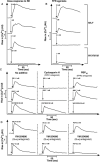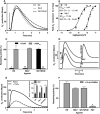Functional selective FPR1 signaling in favor of an activation of the neutrophil superoxide generating NOX2 complex
- PMID: 33040403
- PMCID: PMC8246850
- DOI: 10.1002/JLB.2HI0520-317R
Functional selective FPR1 signaling in favor of an activation of the neutrophil superoxide generating NOX2 complex
Abstract
The formyl peptide receptors FPR1 and FPR2 are abundantly expressed by neutrophils, in which they regulate proinflammatory tissue recruitment of inflammatory cells, the production of reactive oxygen species (ROS), and resolution of inflammatory reactions. The unique dual functionality of the FPRs makes them attractive targets to develop FPR-based therapeutics as novel anti-inflammatory treatments. The small compound RE-04-001 has earlier been identified as an inducer of ROS in differentiated HL60 cells but the precise target and the mechanism of action of the compound was has until now not been elucidated. In this study, we reveal that RE-04-001 specifically targets and activates FPR1, and the concentrations needed to activate the neutrophil NADPH-oxidase was very low (EC50 ∼1 nM). RE-04-001 was also found to be a neutrophil chemoattractant, but when compared to the prototype FPR1 agonist N-formyl-Met-Leu-Phe (fMLF), the concentrations required were comparably high, suggesting that signaling downstream of the RE-04-001-activated-FPR1 is functionally selective. In addition, the RE-04-001-induced response was strongly biased toward the PLC-PIP2 -Ca2+ pathway and ERK1/2 activation but away from β-arrestin recruitment. Compared to the peptide agonist fMLF, RE-04-001 is more resistant to inactivation by the MPO-H2 O2 -halide system. In summary, this study describes RE-04-001 as a novel small molecule agonist specific for FPR1, which displays a biased signaling profile that leads to a functional selective activating of human neutrophils. RE-04-001 is, therefore, a useful tool, not only for further mechanistic studies of the regulatory role of FPR1 in inflammation in vitro and in vivo, but also for developing FPR1-specific drug therapeutics.
Keywords: Biased signaling; Chemotaxis; Formyl peptide receptors; NADPH-oxidase; Neutrophils; Small compounds.
©2020 Society for Leukocyte Biology.
Conflict of interest statement
P.O. and R.H. declare conflicts of interest: they are cofounders of Pronoxis AB, which has a commercial interest in the development of the FPR1 agonists such as the class of compounds represented by RE‐04‐001. The other authors declare no conflicts of interest.
Figures







Comment in
-
Can you teach an old receptor new tricks?J Leukoc Biol. 2021 Aug;110(2):217-218. doi: 10.1002/JLB.2CE0920-568R. Epub 2020 Nov 6. J Leukoc Biol. 2021. PMID: 33155721 No abstract available.
References
-
- Jones HR, Robb CT, Perretti M, Rossi AG. The role of neutrophils in inflammation resolution. Semin Immunol. 2016;28:137‐145. - PubMed
-
- Dahlgren C, Gabl M, Holdfeldt A, Winther M, Forsman H. Basic characteristics of the neutrophil receptors that recognize formylated peptides, a danger‐associated molecular pattern generated by bacteria and mitochondria. Biochem Pharmacol. 2016;114:22‐39. - PubMed
-
- Tsai YF, Yang SC, Hwang TL. Formyl peptide receptor modulators: a patent review and potential applications for inflammatory diseases (2012‐2015). Expert Opin Ther Pat. 2016;26:1139‐1156. - PubMed
Publication types
MeSH terms
Substances
LinkOut - more resources
Full Text Sources
Research Materials
Miscellaneous

